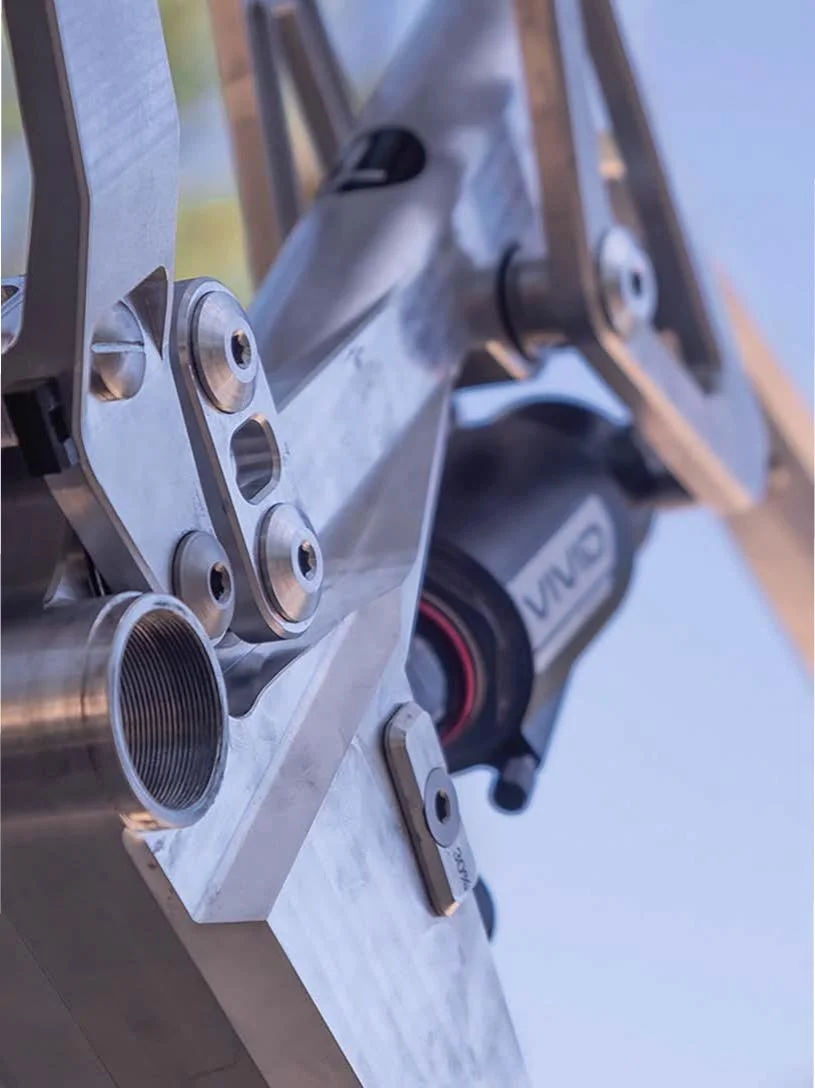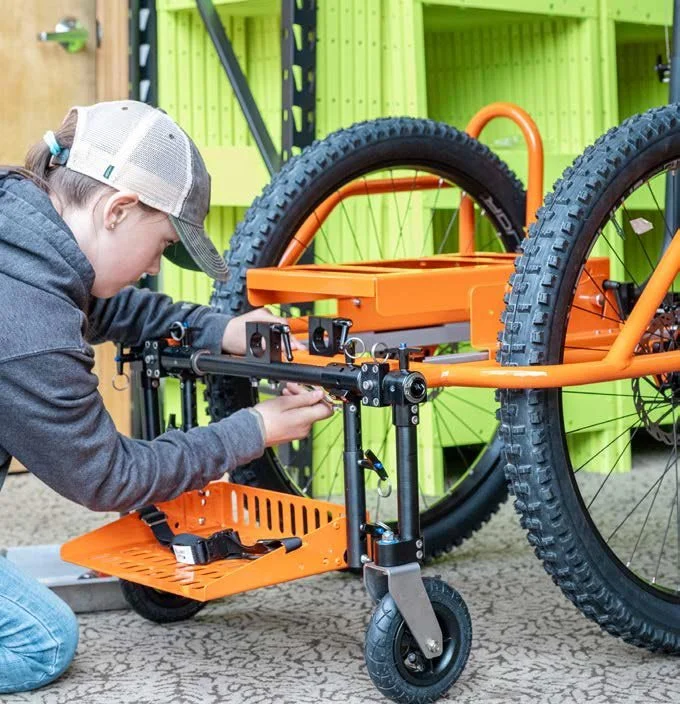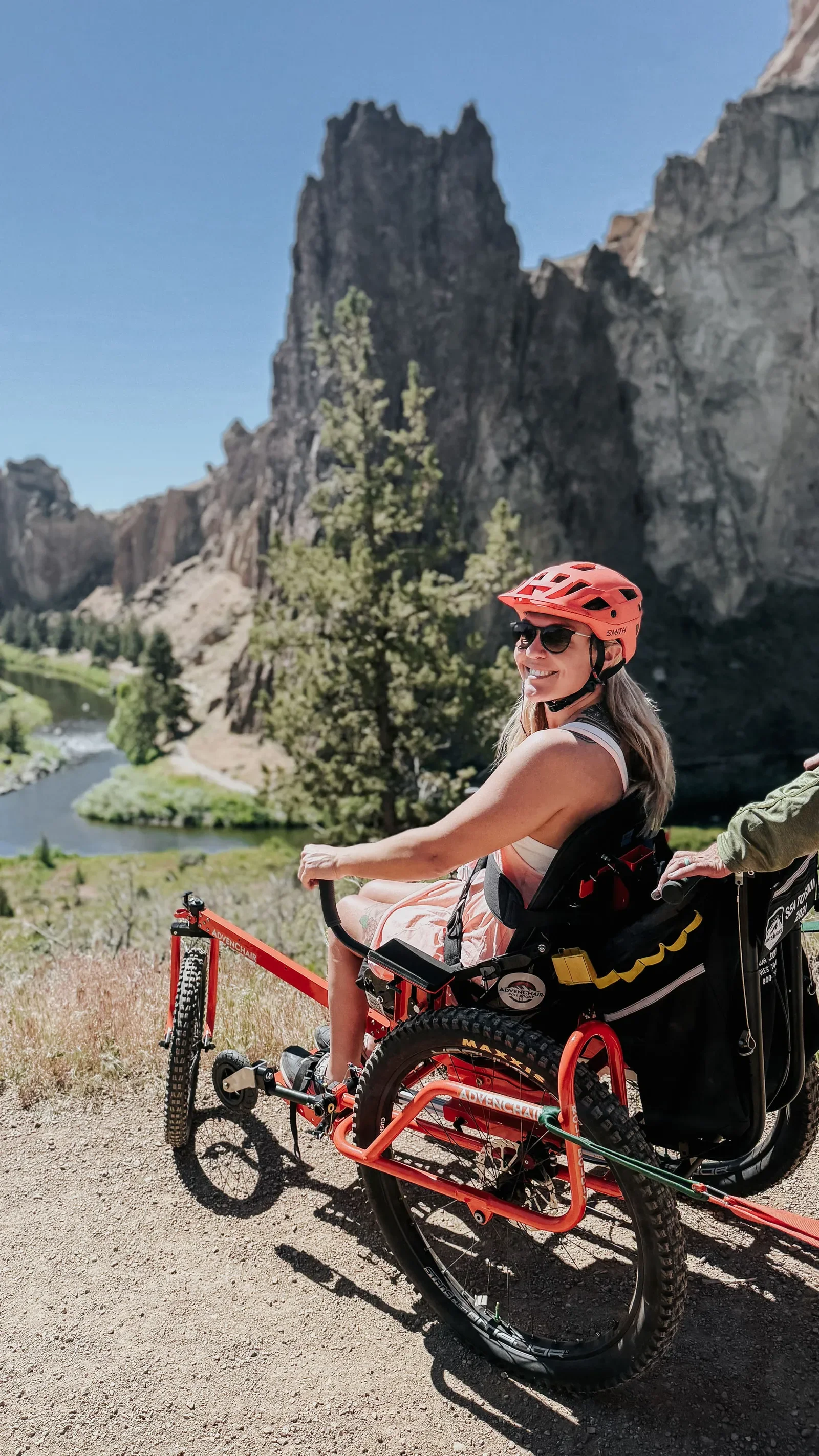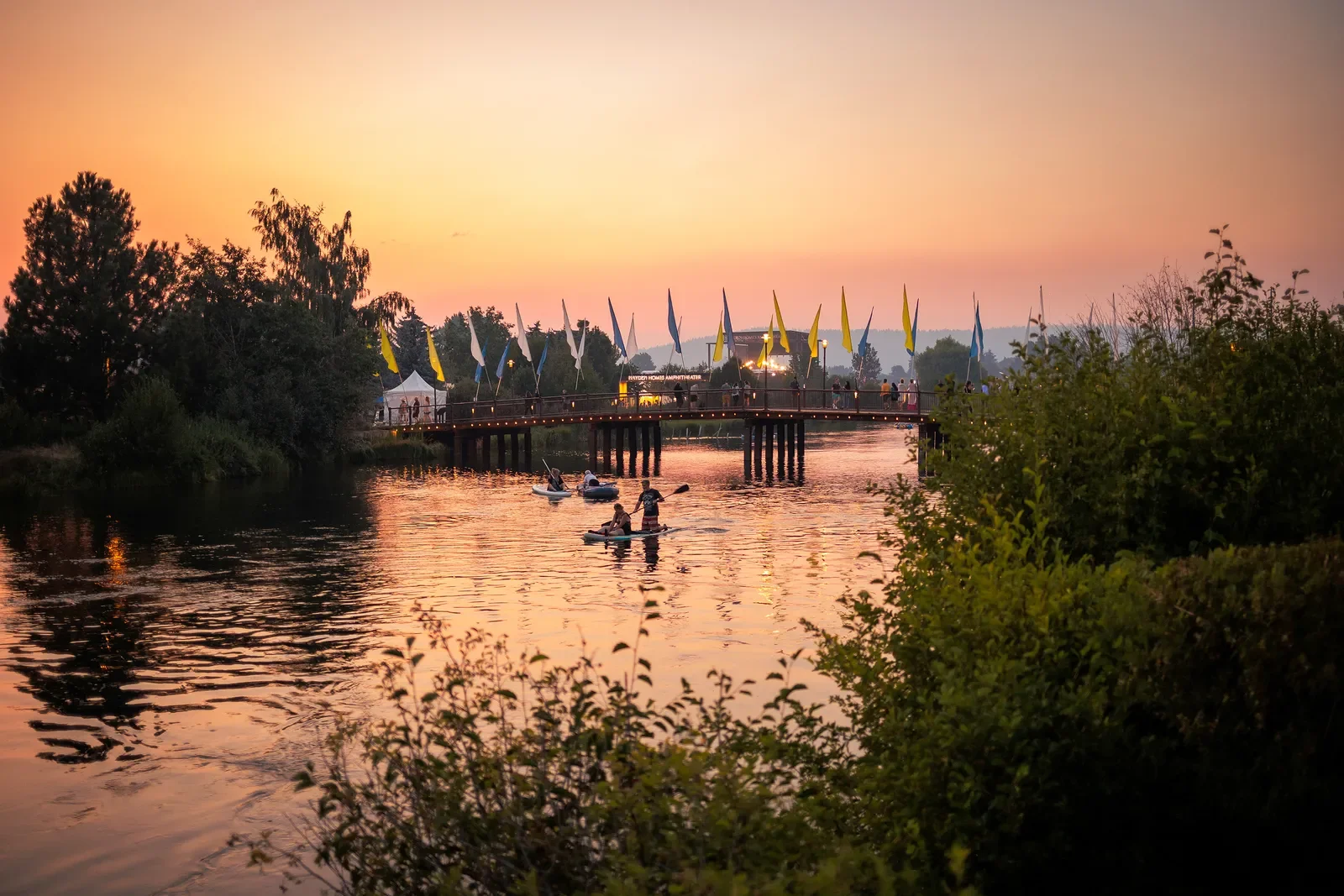Built to Ride
Bend Magazine writer Daniel O’Neil features the AdvenChair wheelchair that thinks its a mountain bike in his Sept/Oct 2025 article “Built to Ride—Custom bikes are a growing industry.” Downhill, cross-country, touring, road, gravel—the high desert offers every option a cyclist could ask for. It follows, then, that the area is also home to a core group of custom bike builders who are pushing bicycle engineering and production past any preconceived boundaries, while also maintaining the spirit of elation and freedom that cycling can provide.
Bend Magazine September-October 2025 Issue
Built to Ride
By Daniel O’Neil for Bend Magazine
Custom bikes are a growing industry
Downhill, cross-country, touring, road, gravel—the high desert offers every option a cyclist could ask for. It follows, then, that the area is also home to a core group of custom bike builders who are pushing bicycle engineering and production past any preconceived boundaries, while also maintaining the spirit of elation and freedom that cycling can provide.
In the United States, about 20 million bikes are sold each year, generating a market revenue of $8 billion. Some 98% of these bikes are manufactured in Asia. This may seem like an unfair headwind for Central Oregon’s bike companies, but instead they use it to their advantage by providing a custom bike build experience.
As Central Oregon’s trail systems expand and more cyclists move to the area, the pack of custom bike companies is gaining speed. Their market, from local to international cyclists, is starting to take notice.
PURSUING PERFECTION
Argonaut Cycles designs and builds some of the world’s most customized road and gravel bikes, which start at $16,000. Founded by Ben Farver in 2007, today Argonaut rolls out 200 high-end bikes a year, all made by hand starting with raw sheets of carbon fiber. Design, product testing and fabrication all happen in Central Oregon.
For cyclists who have spent enough time in the saddle to become one with their bike, customization offers an opportunity to exploit the benefits of different bike-frame geometries and flex patterns. Rather than ride a bike designed for a predetermined style of riding, and a particular weight and height range, a custom bike fine tunes performance. places offer such a surreal yet delightful expanse of climates, altitudes, and, it turns out, attitudes.
For the love of it
Due to steeper prices, and the challenges of reaching a niche market, custom bike building is a small but strong segment in Central Oregon. Without the deeper financial resources of major bike brands, custom builders rely on commitment and stoke instead.
Bend-grown 21-year-old Ethan Eggert founded Arid Cycles after high school. Arid’s full-suspension mountain bike frames are modular, allowing for a rider to select customized options when building the frame. Still in the prototype phase, Eggert plans to open pre-orders this fall. He’s proud to have stayed in Bend to pursue his project. “The market for high-end is there, and it still has room to grow,” Eggert said. “We’re in a good place because we have what people are looking for that they can’t find at the other brands.”
Besides the technical merits, working with a custom builder offers real-life value, allowing rider and builder to develop a relationship like that between surfer and shaper. “You’re supporting someone who’s passionate about what they’re making,” said Max Keegan, who custom welds about three to five bike frames a year as part of his project, Mostly Forever. Frames sell for between $1,900 and $2,500. “It’s sort of the farm-to-table deal, a closer circle. I get the materials, I make a bike frame, and I give it to you—versus a bike frame made overseas, shipped to a distribution center and then shipped to a bike shop.”
Ethan Eggert founder of Arid Cycles
Arid Cycles custom frame
Cyclists from Bend and beyond are becoming aware of the incomparable custom-build options taking off in Central Oregon. “For those riders who have been on the other top-shelf bikes, there’s a growing segment of folks who are looking for something different, cooler and more progressive that separates their riding and puts it on the next level of what’s possible,” Argonaut’s Rudisill said. As far as cycling in Central Oregon goes, from its extensive trail options and routes to its emerging custom builds, nothing is impossible.
click to enlarge
Access for all
Geoff Babb, founder of AdvenChair
photo by Cody Reux
Rich in innovation and collaboration, Central Oregon does not limit itself. When Geoff Babb suffered a paralyzing stroke in 2005, he refused to give up his passion for trails. In response, Babb pursued an off-road wheelchair that could explore places like the Grand Canyon. Babb tested his first AdvenChair in 2016, and today his volunteer-run nonprofit provides all-access wheelchairs for people from age 6 to 96 who previously couldn’t get to places such as Smith Rock in a standard wheelchair.
An AdvenChair costs around $12,000, but Babb works with outdoor schools and tour operators in the United States and beyond to make the chairs themselves more accessible. “We’re allowing a whole range of people to be outside enjoying nature,” Babb said.
Each AdvenChair is made by hand
photo by Eleanor Moseman
Central Oregon’s strong sense of community and entrepreneurship provided the ideal environment for AdvenChair to get rolling. “Really important locally is just being in Central Oregon where there are so many small businesses, so many startups,” said Babb. “I really benefited from being in this incubator, in this small, very supportive group of companies.”
In Bend, Oregon, Outdoor Adventure Belongs to Everyone
Condé Nast writer Sophie Morgan visits Central Oregon and is impressed by the accessibility to its natural environment, thanks to the AdvenChair hiking wheelchair. “Surrounded by a grinning team of able-bodied volunteers, all strapped onto the Advenchair with ropes, they prepared to lower me into what felt like the set of an epic Western. Smith Rock, a jagged, rust-red marvel shaped by ancient lava and sculpted by wind and water, rises from the Oregon desert like a sandstone cathedral. Ahead of me lay a trail that clung to the cliffside. Behind me: the rope team affectionately known as the “mules.” By all logic, this terrain should have been off-limits to someone like me. But this environment was nothing to the Advenchair, Geoff had taken it to the depths of the Grand Canyon previously.”
halbergman/Getty
By Sophie Morgan for Condé Nast Traveler
On a visit to this adventure magnet, Sophie Morgan goes for a trek in the high desert in an off-roading wheelchair and catches an outdoor concert, washed down, of course, with a few pints of local craft beer.
Bend, Oregon. It is one of those places people talk about with a kind of reverence. “Oh, Bend,” they’ll say, drawing out the vowel like there is a secret there that will only be revealed when you go. A renowned outdoor adventure capital, it draws climbers, kayakers, and powder chasers in droves. But as a wheelchair user, I wasn’t sure if that secret extended to people like me. Curious by nature and intrepid by design, I went to find out.
This small city, tucked into the dry side of the Central Oregon Cascades, home to just over 100,000 people, gets over 300 days of sunshine a year, yet Mt. Bachelor—just 22 miles away— collects an average of 462 inches of snow every winter. The city is hemmed in by more than 1.6 million acres of ponderosa pine forest, laced with nearly 300 miles of biking trails, and yet a mere 20-minute drive away the landscape shifts dramatically into high desert plateaus, where temperatures soar to 90°F in peak summer.
Meaning that within the span of one day, you can sip a hoppy IPA in the sunshine at one of the 30+ craft breweries (the highest per-capita rate in the U.S.), carve through alpine powder, paddle the Deschutes River, and still have time for an afternoon bike ride. The choice of outdoor activities are seemingly endless; few places offer such a surreal yet delightful expanse of climates, altitudes, and, it turns out, attitudes.
Within a few hours of arriving, I was strapped into a bright-orange, off-road wheelchair heading to one of the Bend-area’s most popular attractions, Smith Rock State Park. The AdvenChair, a uniquely human-powered, all-terrain chariot was created by Geoff Babb, a local legend who, after losing the ability to walk after a stroke in 2005, refused to be exiled from the wild, so he built his way back in. Necessity being the mother of all invention, after all.
The writer, Sophie Morgan, in an AdvenChair at Smith Rock
In and around Bend, Oregon —Sophie Morgan
Surrounded by a grinning team of able-bodied volunteers, all strapped onto the Advenchair with ropes, they prepared to lower me into what felt like the set of an epic Western. Smith Rock, a jagged, rust-red marvel shaped by ancient lava and sculpted by wind and water, rises from the Oregon desert like a sandstone cathedral. Ahead of me lay a trail that clung to the cliffside. Behind me: the rope team affectionately known as the “mules.” By all logic, this terrain should have been off-limits to someone like me. But this environment was nothing to the Advenchair, Geoff had taken it to the depths of the Grand Canyon previously.
“For me, it’s never been about conquering the trail, or the outdoors,” Geoff told me. The train of people all paused to let us talk above the Crooked River, its serpentine bend glowing in the afternoon light, a blue-winged heron glided just above the water while the canyon walls rippled in ochre and gold around us. “It’s about belonging to it and helping others feel like they do too.”
—Geoff Babb
Wanderlust Tours, one of Central Oregon’s most experienced outfitters, was guiding us both through the park. Geoff partnered with the company to extend their offering to those of us with physical disabilities, specifically people like Geoff with limited or no upper body strength. Familiar with adaptive adventures myself, I had expected adrenaline, but what I hadn’t expected was the teamwork, the way the ‘mules’ moved as one, hauling, guiding, laughing, and making the impossible feel ordinary.
“There’s something powerful about seeing a place become more accessible,” said Jared Garfield, lead ‘mule’ and one of Wanderlust’s guides. “The outdoors can feel overwhelming. That’s why the right equipment matters. But so do the right people. When you have both, you can bring more folks into places like them, especially those who’ve been told it’s not for them. We want everyone to feel included.”
This is a sentiment I would come to find implicit during my time in Bend; the values people take into the wilderness—respect, collaboration—don't disappear when they come back into town. They seep seamlessly into the atmosphere, shaping the way the city feels. And thanks to local advocates like Geoff, or local drag icon Pattie Gonia, that attitude is inclusive, enabling those of us who navigate the world differently, be that disabled, queer, or any other marginalized outdoor lover, access, an invitation to break the mould and redefine the stereotype of an outdoor lover.
Back in town, writer Tim Neville of Visit Bend showed me around the Old Mill District, once a timber hub, now a cultural centre, and into the vibrant downtown, where murals bloomed across brick walls, and record stores sat shoulder-to-shoulder with boutique shops, coffee bars and outdoor outfitters, and talked me through Bend’s long history.
Long before the climbers and cyclists arrived, this land was home to the Confederated Tribes of Warm Springs. For thousands of years, they fished and traded along the Deschutes River, which ran through the city, as it still does, like a lifeline. Bend’s modern incarnation, born in the late 1800s with the arrival of the Europeans chasing the timber trade, has now grown into a recreation capital of the Pacific Northwest. But its Indigenous history runs deeper than any trail map and can be uncovered at the brilliant local High Desert Museum.
Today, Bend’s outdoor spirit is being shaped by organizations like Wanderlust and local nonprofit Oregon Adaptive Sports (OAS) who cater for sports lovers with disabilities of all kinds. “People live in Bend because they choose to,” explains Cara Frank, OAS’s executive director, who is deaf and moved to Bend from the East Coast, despite there being a shortage of interpreters in the local area, a testament to her adoration for the place. “That makes a difference; we care about this place and therefore about who gets to access it.”
The Deschutes River, which flows through Bend, at sunset Angelo DeSantis/Getty
Cara gathers a group of OAS’s volunteers and adaptive athletes at Crux Fermentation Project, for a communal sunset. Dogs—including her own deaf pup—outnumbered people. I met Ryan Barbee, an adaptive mountain biker and fellow spinal cord injury survivor who had, like Cara, also moved to Bend because of how free it made her feel. She greeted me with trail dust on her wheels and a pint in hand. “The first thing you need to know about Bend is the community,” she said, gesturing to the crowd, where wheelchairs and mountain bikes blended in. “And OAS is the heartbeat of it.”
The food scene in Bend is also wonderfully ambitious. One standout is Hawkeye & Huckleberry Lounge, the new venture from brothers Brian and James Malarkey, who recently returned to their home state with a vision to bring a slice of ranch life into the heart of town. Set around a wood-fired oven, the restaurant has canvas tent dining, a lively outdoor patio, live music, and a menu that leans into their ranch-to-plate philosophy, with beef and produce sourced from their nearby Tumalo Ranch. Think high-quality steaks and hearty, unfussy food served with a generous dose of Oregon hospitality.
And just like the food, Bend’s music scene hits all the right notes. Later, I rolled into Hayden Homes Amphitheater, a performance venue on the Deschutes. Leon Bridges was serenading a sun-drenched crowd beneath a sherbet-orange sky while I sat comfortably in the accessible seating area, surrounded by a joyful sprawl of dancing hikers, hipsters, families, and fellow disabled folks—totally smitten.
Inclusion can be an elusive feeling for disabled people, hard to define, harder still to find. As I cruised home past the Craftsman bungalows and ponderosa pines that lined the streets, I caught myself not just longing to return but imagining a life here, and even after just a few days, feeling like I already belonged. On my final day, I sat with Geoff in his home talking about the creation of his ground-breaking chair. “A wheelchair chair powered by people?” he said. “That could only come from Bend.” I nodded in agreement, now finally in on the secret.
Where to Stay
The Oxford Hotel is an eco-luxury boutique hotel in the heart of downtown Bend; it’s ideal for walking or rolling to nearby shops and cafés. For a modern, pet-friendly place to stay, check out Element Bend. It’s located just off of Pioneer Park and very close to the Deschutes River, which winds through the city. Just outside town you’ll find the Tetherow. This upscale resort is tucked between forest and fairway. Stylish, accessible accommodations, and mountain views make it a peaceful retreat after a day spent outdoors.
Where to Eat and Drink
The lively downtown outpost of Thump Coffee is a community hub for coffee lovers—it’s step-free and just the spot for either a quick on-the-go espresso or a slow morning spent with a cardamom latte and a flaky pastry. Drake, a downtown bistro, serves American comfort food with fresh, local ingredients: the deviled eggs, burger, and seasonal cocktails are must-orders. A globally inspired restaurant born from a food truck, Spork is now one of Bend’s most popular spots and loved for its street food fusion and a laid-back vibe: don’t miss the spicy pork noodles. Wood-fired mains, creative cocktails, and live music in the dining area make Hawkeye & Huckleberry Lounge a standout for dinner. The riverside Deschutes Brewery is the original Bend brewery and still the most iconic, serving a large selection of craft beers and tasting flights alongside pub classics in a relaxed, accessible setting. Crux Fermentation Project, a beloved brewer-owned spot with panoramic mountain views, has a rotating menu of small-batch beers, food trucks, and a lively, accessible outdoor lawn. Check it out at sunset.
The author, Sophie Morgan in Morocco
Sophie Morgan
After training in Fine Art at Goldsmiths College, Sophie turned to broadcasting, a career that gave her a ticket to travel the world. As a TV Presenter, Producer, travel writer and ambassador for brands such as Airbnb, CanAm and PADI, Sophie, recently selected for Women Who Travel's Power List, is on a quest to find the perfect accessible space. Her bucket list includes adapted mountain biking in the Rockies and, one day, riding around the world on her Ryker.













